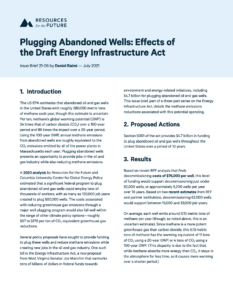Full Title: Plugging Abandoned Wells: Effects of the Draft Energy Infrastructure Act
Author(s): Daniel Raimi
Publisher(s): Resources for the Future
Publication Date: July 14, 2021
Full Text: Download Resource
Description (excerpt):
The US EPA estimates that abandoned oil and gas wells in the United States emit roughly 280,000 metric tons of methane each year, though this estimate is uncertain. Per ton, methane’s global warming potential (GWP) is 34 times that of carbon dioxide (CO2) over a 100-year period and 86 times the impact over a 20-year period. Using the 100-year GWP, annual methane emissions from abandoned wells are roughly equivalent to the CO2 emissions emitted by all of the power plants in Massachusetts each year. Plugging abandoned wells presents an opportunity to provide jobs in the oil and gas industry while also reducing methane emissions.
A 2020 analysis by Resources for the Future and Columbia University Center for Global Energy Policy estimated that a significant federal program to plug abandoned oil and gas wells could employ tens of thousands of workers, with as many as 120,000 job years created to plug 500,000 wells. The costs associated with reducing greenhouse gas emissions through a major well plugging program would also fall well within the range of other climate policy options—roughly $67 to $170 per ton of CO2-equivalent greenhouse gas reductions.
Several policy proposals have sought to provide funding to plug these wells and reduce methane emissions while creating new jobs in the oil and gas industry. One such bill is the Energy Infrastructure Act, a new proposal from West Virginia Senator Joe Manchin that earmarks tens of billions of dollars in federal funds towards environment and energy-related initiatives, including $4.7 billion for plugging abandoned oil and gas wells. This issue brief, part of a three-part series on the Energy Infrastructure Act, details the methane emissions reductions associated with this potential spending.
